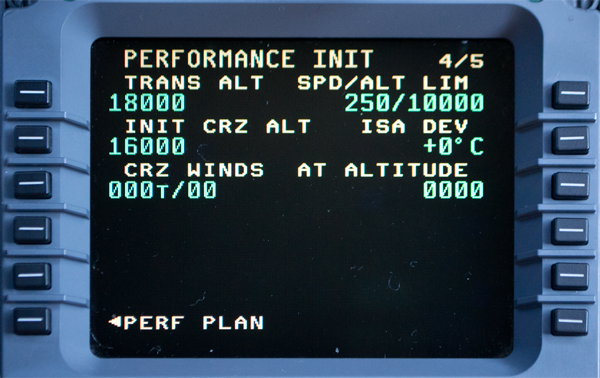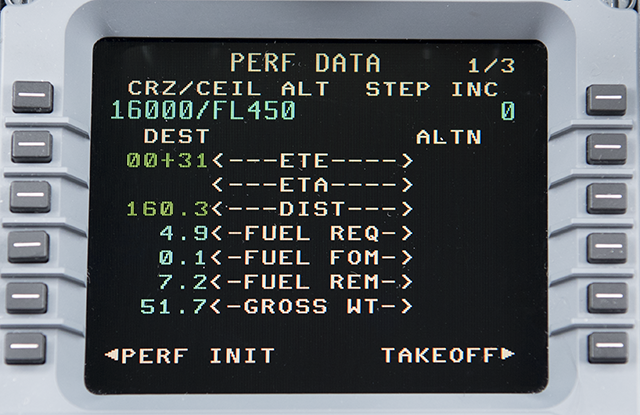Cruise Altitude Selection
- James Albright (a former G450 driver)
Updated: 2013-10-29
How high can you go? How high do you want to go?
This was a matter of serious debate in the GV since the range of intelligent choices was so wide: from FL410 to FL510. In the G450 it is a bit easier: you can almost always make it to FL410 and the benefits for going up to FL450 are not as extreme. But there is still a decision to be made.
Everything here is from the references shown below, with a few comments in an alternate color.
Photo: from Haskel's cockpit.
Cockpit Resources
PERF DATA
[Gulfstream G450 Aircraft Operating Manual §2B-26-40] If optimum altitude is selected for the initial cruise altitude on PERFORMANCE INIT page 4/5, then the computed optimum altitude is displayed as the cruise altitude on PERF DATA page 1/3. If an initial cruise altitude is entered (e.g., 45000 ft), this altitude is displayed as the cruise altitude on PERF DATA page 1/3.
If the altitude preselector is dialed to a higher altitude than the cruise altitude on PERF DATA page 1/3, then this field will be updated automatically. The initial cruise altitude on PERFORMANCE INIT page 4/5 remains unaffected by the automatic adjustments. If the cruise segment is actually flown at a lower altitude than the cruise altitude on PERF DATA page 1/3, then a new cruise altitude should be entered by the pilot in this field. If the new cruise altitude is not entered, a climb is predicted since the FMS is expecting a climb to the cruise altitude displayed on PERF DATA page 1/3.
The ceiling altitude is the highest attainable altitude of the aircraft for the given cruise conditions. The ceiling altitude is limited to the certified ceiling altitude. The ceiling altitude depends on the cruise speed mode as well as gross weight and air temperature. Prior to reaching cruise, predicted gross weight and air temperature values at top of climb (TOC) are used to compute ceiling altitude. Once in cruise, the current weight and outside air temperature are used.
For the MAX SPEED and the MAX END cruise modes, the highest altitude that can be attained is computed and displayed as the ceiling altitude. For the LRC cruise mode, the ceiling altitude is computed for the LRC schedule. For the manual cruise mode, the ceiling altitude is computed for the entered CAS or MACH.
[Gulfstream G450 Aircraft Operating Manual §2B-26-00 pg. 22] The optimum altitude has different definitions based on the cruise speed mode. For the LRC and manual cruise speeds, the optimum altitude is where the specific range is optimized. This altitude is typically close to the ceiling altitude. The MAX SPD optimum altitude is where true airspeed is maximized. This altitude tends to be close to the VMO/MMO crossover altitude. For MAX END speed, the optimum altitude is where the fuel flow is minimized. For MXR SPD, the optimum altitude is where true airspeed is maximized while ensuring the destination can be reached based on fuel quantity.
CRUISE
[Gulfstream G450 Aircraft Operating Manual §2B-26-70] 1L - The cruise altitude is displayed here. It is the same altitude as the cruise altitude on the PERF DATA 1/3 page. Entries are made in FL or in feet. Entering *DELETE* initiates a recomputation of the optimum altitude.
1R - The optimum altitude and step climb altitude are displayed here. No entries are permitted. The optimum altitude is the current optimum altitude depending on the current gross weight, temperature, and scheduled cruise speed. The current airspeed does not matter. This is because the optimum altitude definition changes with the speed mode. The step altitude reflects the sum of the cruise altitude and the step increment.
As it turns out, the first place you will probably look is the worst place you can look. The CRZ ALT will simply show whatever you've entered on page 4 of PERF INIT, since you never leave this as OPTIMUM. The book does a poor job of explaining CEIL ALT and OPT ALT. Can you always make it up to CEIL ALT? No. Will flying at OPT ALT always be optimal? No.
It has been my experience that if the temperature conditions agree with the PERF INIT and are consistent from your current altitude all the way up to your TOC, then they are probably good. Otherwise, read on . . .
Performance Handbook
Figure: Twin engine flight planning performance, from G450 Performance Handbook §PB-1
[G450 Performance Handbook §PB-1]
Section PB of the Performance Handbook gives you an idea of where your 200 FPM ceiling is for 0.80M, 0.83, 0.85, and for 0.86 at a variety of temperature conditions. Select the appropriate gross weight and find the underlined NAM/LB figure. That's as high as you want to go.
The Higher is Better Debate
Figure: Cruise altitude selection, from G450 Performance Handbook §PB-18
The higher you go the better, right? Well yes, but it isn't quite black and white. I once flew a GV charter from Rio De Janeiro, Brazil to Geneva, Switzerland, a flight of about 5,000 nm. We were the second airplane of a two-airplane charter, the first being flown by Net Jets. We flew at FL 470, 0.83M; they flew at FL 390, 0.85M. They got there fifteen minutes earlier and consumed an extra 10,000 pounds of fuel.
Is this lesson applicable to the G450? Perhaps. Once you pass the point where the temperature lapse rate becomes constant, the fuel savings increment becomes almost negligible in the G450:
Results of an informal Haskel Study, 2010
Using KLAX to KBED, for example, flying at FL410 versus FL450 costs you only 400 lbs of fuel but gets you there 3 minutes sooner since you spend less time in the climb.
Therefore, you shouldn't use fuel as the sole determinant of altitude selection. Winds are far more important a factor in fuel usage.
References:
Gulfstream G450 Aircraft Operating Manual, Revision 35, April 30, 2013.
Gulfstream G450 Performance Handbook, GAC-AC-G450-OPS-0003, Revision 20, November 30, 2011







